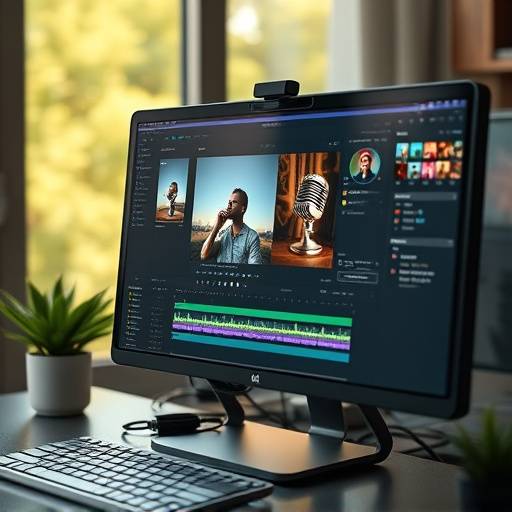
Mastering Microphone Techniques for Crystal-Clear Audio
Published on October 26, 2024 by Elias Vance
Achieving high-quality audio is paramount for a successful podcast. One of the most critical factors is your microphone technique. Whether you're a seasoned podcaster or just starting, understanding how to properly use your microphone can significantly improve your audio clarity and listener experience. In this post, we'll delve into essential microphone techniques used at SonicBloom Studios to ensure your voice sounds its best.
Distance Matters:
The distance between your mouth and the microphone profoundly impacts your audio. Generally, a distance of 4-6 inches is ideal. Too close, and you risk plosives (those harsh 'p' and 'b' sounds) and an overly bassy sound. Too far, and you'll pick up more room noise and lose vocal presence. Experiment to find the sweet spot for your microphone and voice.
The Angle of Attack:
Avoid speaking directly into the microphone. Instead, position the microphone slightly off-axis (at a slight angle). This helps reduce plosives and sibilance (excessive 's' sounds). At SonicBloom Studios, we often use a pop filter in conjunction with an off-axis position for optimal results.
Gain Staging is Key:
Proper gain staging involves setting your microphone input level to an appropriate level. The goal is to get a strong, clean signal without clipping (distortion caused by excessive input). Monitor your audio levels while speaking at your normal volume. Adjust the gain until your loudest peaks reach around -6dBFS on your recording software.
Room Acoustics:
Your recording environment plays a crucial role in your audio quality. A room with hard, reflective surfaces will produce echoes and reverberation. Ideally, record in a room with soft surfaces like carpets, curtains, and acoustic panels. If you don't have access to a professional studio, consider using a closet or draping blankets around your recording area to dampen the sound.
Invest in a Pop Filter and Shock Mount:
A pop filter is a simple yet effective tool for reducing plosives. A shock mount isolates the microphone from vibrations that can travel through the stand, preventing unwanted noise in your recordings. These are standard equipment at SonicBloom Studios for a reason – they work wonders!
Read More

Podcast Editing Essentials: Crafting a Polished Listening Experience
Published on October 19, 2024 by Anya Petrova
Podcast editing is where raw recordings transform into a compelling and engaging listening experience. It's more than just cutting out mistakes; it's about shaping the narrative, enhancing audio quality, and creating a professional-sounding product. At SonicBloom Studios, our editing process is meticulous and detail-oriented. Here’s a glimpse into our essential podcast editing practices.
Choosing the Right Software:
Several excellent DAWs (Digital Audio Workstations) are available for podcast editing, including Adobe Audition, Audacity (free), and Logic Pro X. The best choice depends on your budget, skill level, and specific needs. We primarily use Adobe Audition for its advanced features and seamless integration with other Adobe products.
Noise Reduction:
Removing unwanted background noise is often the first step in the editing process. Techniques like noise reduction and spectral editing can help eliminate hums, hisses, and other distractions. Be careful not to overdo it, as excessive noise reduction can make your audio sound unnatural.
Compression and EQ:
Compression evens out the dynamic range of your audio, making it sound louder and more consistent. EQ (equalization) allows you to shape the tonal balance of your audio, boosting certain frequencies and reducing others. Use these tools to enhance vocal clarity and create a balanced sound.
Adding Music and Sound Effects:
Carefully selected music and sound effects can add depth and interest to your podcast. Use them sparingly and ensure they don't overpower your vocals. Royalty-free music and sound effects libraries are readily available online.
Mastering for Consistency:
Mastering is the final stage of the editing process, where you optimize the overall loudness and sonic characteristics of your podcast. The goal is to ensure your podcast sounds consistent across different playback devices and platforms. We use industry-standard mastering techniques at SonicBloom Studios to deliver a polished final product.
Read More

Strategies for Podcast Growth: Expanding Your Audience in Baltimore and Beyond
Published on October 12, 2024 by Jamal Jefferson
Creating a great podcast is only half the battle. Growing your audience requires a strategic approach that encompasses marketing, promotion, and audience engagement. At SonicBloom Studios, we help our clients develop comprehensive growth strategies tailored to their specific podcast and target audience. Here are some proven techniques to expand your podcast's reach.
Optimize Your Podcast for Search:
Just like websites, podcasts can be optimized for search engines. Use relevant keywords in your podcast title, description, and episode titles. Submit your podcast to popular podcast directories like Apple Podcasts, Spotify, and Google Podcasts. This will make it easier for potential listeners to discover your podcast.
Leverage Social Media:
Social media is a powerful tool for promoting your podcast and engaging with your audience. Create a dedicated social media presence for your podcast and share snippets, behind-the-scenes content, and episode updates. Engage with your followers and encourage them to share your podcast with their networks.
Guest Appearances and Cross-Promotion:
Collaborate with other podcasters and influencers in your niche. Guest appearances on other podcasts can expose you to a new audience, while cross-promotion with other creators can drive traffic to your podcast.
Engage with Your Audience:
Build a community around your podcast by actively engaging with your listeners. Respond to comments, answer questions, and solicit feedback. Consider creating a Facebook group or online forum where listeners can connect with each other and discuss your podcast.
Promote on Local Baltimore Platforms:
Focus on local Baltimore media outlets, community groups, and events. Partner with Baltimore-based businesses or organizations to cross-promote your podcast. Attend local podcasting meetups to network with other creators and learn new strategies. SonicBloom Studios actively participates in the Baltimore podcasting community and can help connect you with valuable resources.
Read More


